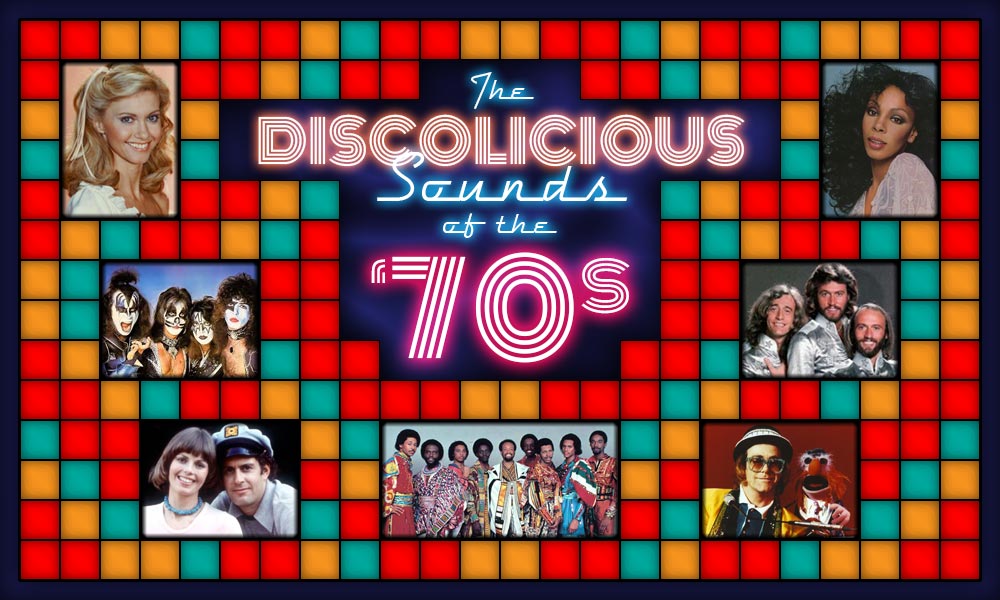
Once again, my compulsion to show off has taken me way off track and, as a result, I’m attempting to collate from an unmanageable mess. As much as I want to share everything (I think) I know, I will forgo (for now) extensively extolling the virtues of early metal, prog, punk, and post-punk/new wave (none of which factored into my experience until much later) and stick to what I personally remember seeing and hearing during the ’70s…
Early on, the media I consumed encompassed a vast array of sound and images hailing from, roughly, a period spanning 1930-1980. Dating back to Mom & Dad’s youth and early adulthood were “shorts” and “full lengths” from old-time comedy teams (Laurel & Hardy, Three Stooges, Abbott & Costello), Little Rascals, vintage Hollywood musicals (Shirley Temple, Big bands, Andrews Sisters, Astaire & Rogers, Garland & Rooney, Crosby & Hope), ’50s TV (Honeymooners, I Love Lucy), Universal’s Classic Monsters, Tarzan movies, & classic cartoons (Looney Tunes, Popeye, Woody Woodpecker, Walt Disney). Selections from the ’60s-early ’70s included TV shows (Munsters, Twilight Zone, Addams Family, Lost In Space, Get Smart, Monkees, Star Trek, Brady Bunch), cartoons (Marvel Super Heroes, Spider-Man, Flintstones, Jetsons, Bullwinkle), Disney films (Doctor Doolittle, Mary Poppins, The Love Bug). …And I was watching contemporary kids stuff (Captain Kangaroo, Romper Room, Sesame Street, Electric Company, Krofft Shows, Fat Albert, Hanna Barbara); National Geographic; game shows (Bowling for Dollars, Price is Right, Gong Show); Superheroes (Six Million Dollar Man, Wonder Woman, Incredible Hulk); Planet of the Apes; Godzilla. If I wasn’t actively watching Sanford & Son, Rockford Files, Rhoda, All In the Family, & Taxi, I was definitely within earshot when they were on. Monday Night Baseball/Football & Wide World of Sports were always getting in the way of watching the “good stuff.” …And it seemed like every year ABC was airing the “World Television Premier” of yet another James Bond flick (but I was only allowed to watch the pre-credit scene before being toted off to bed). Yeah (sigh), I watched a lot of TV.
AYYYYYYYYYYYYYYYYYYYY AND YAAAAAAAYYYYYYYYYY!!!
The great American hangover that followed the civil rights movement & Vietnam War was often reflected in the media of the day; many films (All the President’s Men, Deer Hunter, Network) mirroring the American people’s growing disillusionment toward once blindly hallowed institutions and shows (White Shadow, Good Times, Maude, One Day At a Time, Diff’rent Strokes) considering changing attitudes toward “traditional” societal norms. It’s not as if there was any shortage of propaganda…err, I mean, good, “clean” fun (reruns of Mister Ed, Leave It to Beaver, Beverly Hillbillies, Green Acres, Hogan’s Heroes), though. Tones were clearly shifting toward “pure” escapism. In an effort to restore our collective (false) sense of security, entertainment was looking backwards – toward more “innocent times” – evident in the music I was hearing: rock & roll “oldies” (Chuck Berry, Elvis, Buddy Holly, Jerry Lee Lewis, Little Richard, Beatles, Beach Boys, The Byrds, Rolling Stones, Yardbirds, The Who, Kinks, Dylan, Simon & Garfunkel, Supremes, Marvin Gaye, Smokey Robinson, Four Tops); hits by contemporary artists like Harry Nilsson (“1941“), Elton John(“Crocodile Rock“), ELO (“Roll Over Beethoven“), Bette Midler (“Boogie Woogie Bugle Boy“), Bay City Rollers (“I Only Want to Be With You“); Stevie Wonder (“Sir Duke“), Billy Joel (“Only the Good Die Young“), & Queen (“Crazy Little Thing Called Love“); and at the movies (American Graffiti, Animal House). Largely hidden from view, the subversive, naughty-campy cult glam musical Rocky Horror Picture Show pieced together many tropes of the decade (nostalgia for “innocent” America, old time rock n’ roll, ’30s-’50s horror/sci-fi). With all the subtlety of a dragster, the ’50s doo wop flipping of “Taming of the Shrew,” Grease, continued John Travolta’s (Welcome Back, Kottar) winning streak & made country pop singer Olivia Newton-John a full-blown mainstream superstar. Closing out a decade full of nostalgic films was perhaps my favorite musical of all time – John Belushi and Dan Ackroyd’s comic ode to classic R&B, The Blues Brothers (“We’re on a mission from God”). Come to think of it, the ’70s closed the door on era of the movie musical, in general. Maybe the glut of weak disco vehicles c. ’79/’80 provided the final blow…? With few exceptions, the role of original music in 1980’s movies had been reduced to fodder for training montages and music videos.
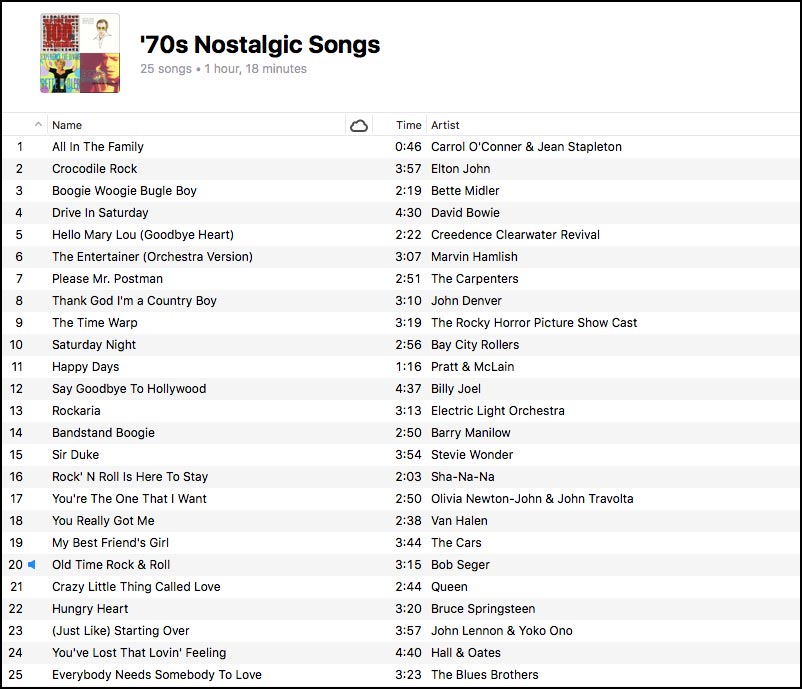
On TV, Korean War-set dramedy M.A.S.H., starring Alan Alda, muted the darker, subversive traits of the hit film and become a beloved institution. Happy Days, starring Opie from The Andy Griffith Show, was, by far, the most influential of all the nostalgic ’70s shows: creditable for spawning many memorable catchphrases (“Sit on it,” “I still got it,” “Ayyyyy,” & “Whoah“) and spin-offs (Laverne & Shirley, Mork & Mindy). For the first few years, at least, Happy Days attempted to present an authentic (if stylized) view of (white) suburban middle-America in the mid-late ’50s: vintage cars, “regular” men’s haircuts, poodle skirts, drive-in restaurant-soda fountains; music by Bill Haley, Fats Domino, Elvis, The Coasters, Everly Brothers, & Crew Cuts. In the tradition of The Archie Show, many episodes included musical numbers performed by cast members & guests (Frankie Avalon, Suzi Quatro). As the seasons piled up and Henry Winkler’s Fonzie (once a background character) became incredibly popular, the show “jumped the shark” due to obtrusive, gimmicky storytelling devices, the shedding of original cast members, and a lax sense of continuity (contemporary fashions, hairstyles, & social content).
Another example of the nostalgia in ’70s media was the ever presence of country-western music entertainers. An integral part of the pop culture landscape long before the advent of rock n’ roll (itself starting out as an amalgam of country & blues), country’s biggest acts were mainstream stars as well: prominently featured on TV (Johnny Cash Show, Glenn Campbell Goodtime Hour, Dolly, Hee Haw); film (Kris Kristofferson in A Star Is Born, Jerry Reed in Smokey & the Bandit); and the pop charts (Kenny Rogers’ “The Gambler,” Anne Murray’s “You Needed Me,” Crystal Gayle’s “Don’t It Make My Brown Eyes Blue“). In rock music, ’60s, artists like The Byrds, Bob Dylan, Neil Young, The Band, Credence Clearwater Revival, and Grateful Dead began more overtly exploring the “old timey” sounds that were always part of their heritage, in turn influencing big ’70s acts (Allman Brothers, Lynyrd Skynyrd, Eagles) who followed close behind. Veteran folk acts from the ’60s like Gordon Lightfoot (“Sundown“) and John Denver (“Thank God I’m a Country Boy“) were now demonstrating pronounced country influences as well. Back on television, the tradition of romanticizing the old west continued with the legacy western Gunsmoke, Waylon Jennings provided the “outlaw” theme for The Dukes of Hazzard, and Little House On the Prairie & The Waltons gave us “feels” for simpler, if harder, times.
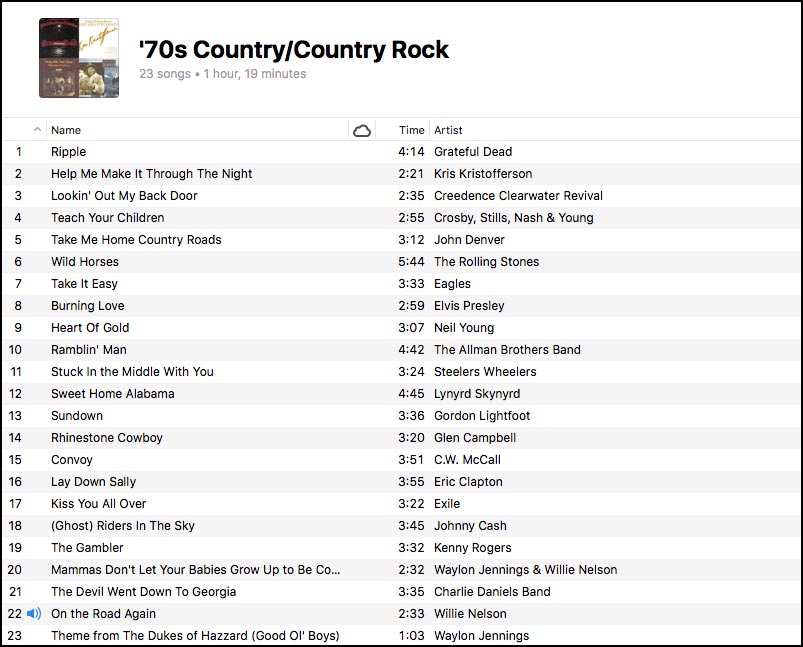
Further evidence confirming the move toward pure entertainment is found in the preponderance of ’70s TV variety/sketch comedy shows (American Bandstand, Laugh In, Sonny & Cher, Soul Train, Tony Orlando & Dawn, Carol Burnett, Jacksons, , Donny & Marie, SNL, Sha Na Na), specials (Bob Hope, Diana Ross, Carpenters, John Denver, Olivia Newton-John), & talk shows (Tonight Show, Mike Douglas, Dick Cavett). The overall quality of these programs was wildly inconsistent and, if you were experiencing your “15 minutes” at any point in that decade, odds were good that a network would offer you a time slot. Always outstanding, however, was The Muppet Show. I was real young and a bias for Jim Henson’s work on Sesame Street surely factors in my high esteem, but the show really was very funny and entertaining for people of all ages. Unlike much “family” entertainment of today, Henson made the show fun for adults and children without being overly crass or intentionally speaking above or below his audience’s assumed intelligence levels. The Muppet characters were all colorful, distinct, funny, and nuanced; repeated gags never felt rote, always finding new angles & fresh laughs (and groans); guest hosts hailed from diverse realms of acclaim (Rita Moreno, Ruth Buzzi, Paul Wiliams, John Denver, Peter Ustinov, Twiggy, Juliet Prowse, Bernadette Peters, Milton Berle, Debbie Harry, Lou Rawls, Steve Martin, Elton John, Gilda Radner, Raquel Welch, Alice Cooper, Helen Reddy, etc.). …And their house band had the snazziest name ever (Dr. Teeth & the Electric Mayhem).
DISCO ‘FECTS
Set to become the most influential touchstone of 1970s culture, disco was already sewing itself into the fabric of the world by the time I was out of diapers. Sure, other significant trends were happening, but almost everything in the mainstream had been seduced: architecture and décor; fashion; scores for TV (Kojak, Love Boat, Wonder Woman, Charlie’s Angels, Starsky & Hutch) & film (Car Wash, Dirty Harry, Rocky, Xanadu); and popular music. Too young, obviously, to have personally partaken of the disreputably decadent club scene, impressions from what I was seeing on TV (Dance Fever) are summed up thusly: mirror balls; blinking, Technicolor checkerboard dance floors; pretty, well groomed, bone-skinny women with long, flowing hair in blousy strapless dresses; smarmy looking hyper-macho “players” with helmet hair wearing wide-open, flared-collar shirts and leisure suits (man-perm, gold medallion, pinky ring, & porn mustache sold separately). My folks liked disco music and were very good dancers, but, with four kids to feed, a mortgage, car payments, etc., they were too busy “adulting” to worry about staying on the tip of what was “happening” and “cool.” If anything, they actually appeared to be willfully devoted to remaining “uncool.” That said, now firmly (if restlessly) ensconced in middle-age myself, I can look back and appreciate that: A) they were comfortable with who they were & knew what they liked; B) what they liked tended to be pretty good when viewed through the wide lens of history; and C) I too no longer give two (expletives) about being cool. That ship has sailed.
God knows I’m guilty of casting stones from time to time when seeing and/or hearing things my brain perceives as utter excrement, but I never understood the vitriol of the Demolition that marked the de facto nadir of disco in mid-’79. In some ways I get it… When thinking back to the embarrassingly tacky, sequin smothered superficiality of the clothes revered, legacy acts were wearing (Elvis, Neil Diamond). But this was the world I was born into. This was “normal” for the ’70s. Anyway… Simmering since around 1970, the disco craze caught fire in the U.S. c. ’75 through music that drew from a variety of forms: Latin beats and polyrhythms); funk & soul (Motown, The Meters, James Brown, Isaac Hayes); the lush symphonic rock of The Moody Blues & Electric Light Orchestra; Phil Spector’s “Wall of Sound“; and the theatricality of Glam. Once media moguls realized disco’s commercial potential, it was, of course, exploited (or weaponized) to the nth degree, at this point influencing R&B icons (Marvin Gaye’s “Got to Give It Up,” Diana Ross’ “Upside Down“), rock institutions (Rolling Stones’ “Miss You,” John Lennon’s “Whatever Gets You Through the Night“), art-rock (David Bowie’s “Golden Years“), Country (Glen Campbell’s “Rhinestone Cowboy,” C.W. McCall’s “Convoy,” Charlie Daniels’ “The Devil Went Down to Georgia“), jazz (Chuck Mangione’s “Feels So Good“), Metal (Kiss’ “I Was Made For Lovin’ You“); pop (Bee Gees’ “Stayin’ Alive,” Captain & Tenile’s “Love Will Keep Us Together,” Elton John’s “Philadelphia Freedom“), & punk (Blondie’s “Heart of Glass“). ’70s icons that seemed to arrive fully-formed with Disco appeal included ABBA (“Dancing Queen“), Earth, Wind & Fire (“Shining Star“), KC & the Sunshine Band (“Get Down Tonight“), Chic (“Le Freak“), and Donna Summer (“Love to Love You“). The airwaves were assaulted with a multitude of novelty acts (Village People, Bony M), 1-hit wonders (“The Hustle,” “Kung-Fu Fighting“), parodies (“Disco Duck“) & adaptations (MECO, “A Fifth of Beethoven“). Amusingly, even though my Dad is a Sinatra-era crooner fan who often responds to the sight of flamboyant performers with intolerance punctuated with unflattering expletives, he sincerely has a soft spot for colorful showmen. To this day, he still brightens up when talking about “that time we saw that crazy Scotsman…you know…awwwww what’s his name(?)… on TV…” (Rod Stewart, in full animal-print gloriousness, promoting his sellout disco single “Do Ya Think I’m Sexy“). Good old Dad.
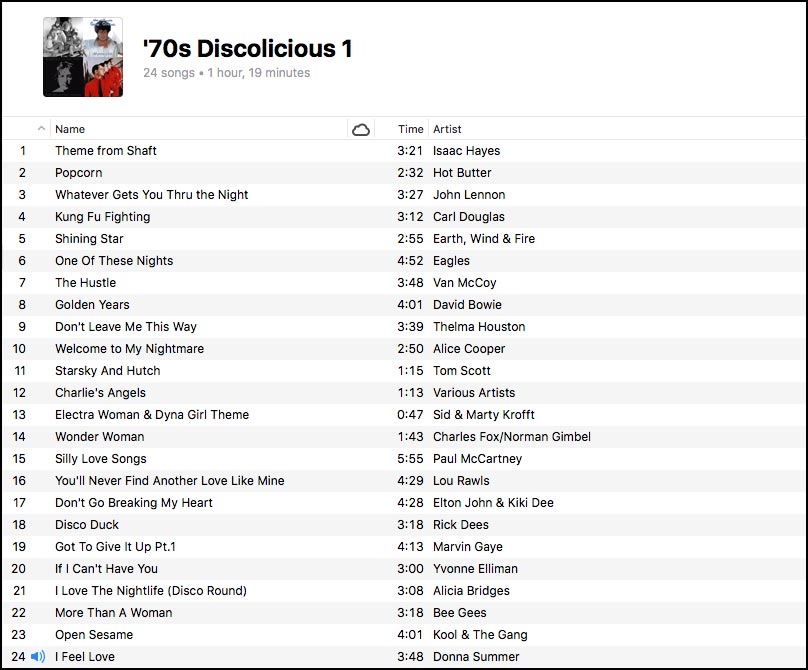
At home, I don’t know if we even had an FM radio yet and we definitely didn’t have many contemporary albums, but a few current tunes found their way onto the family hi-fi. 1977’s K-Tel Pure Gold collected hits from the previous year (Heart’s “Magic Man,” Mary MacGregor’s “Torn Between Two Lovers,” Marvin Gaye’s “Let’s Get It On,” Maxine Nightengale’s “Right Back Where We Started From,” ABBA’s “Fernando” KC’s & the Sunshine Band’s “I’m Your Boogie Man,” etc.). John Williams‘ ’77 Star Wars Soundtrack was a particular influence, helping to fuel what would soon become the most enduing obsession of my childhood. Although it wasn’t current, another orchestral album I was hearing regularly was the soundtrack to Disney’s Fantasia – noteworthy because, roughly the same time I was hearing Mussorgsky’s original “A Night on Bald Mountain,” David Shire’s adaptation, “Night On Disco Mountain” from the Saturday Night Fever Soundtrack, was playing on Mom & Dad’s turntable as well. Permanently etched in my brain from countless repetition, the Fever soundtrack was (is) a stellar distillation disco’s virtues (yes, I said “virtues”), featuring a multitude of R&B and pop artists (Kool & the Gang, The Trammps, Yvonne Elliman) who had gravitated to that style. (In)arguably, the movie itself would have probably tanked like all the other disco-centric films had it not been for the stellar set of songs contributed by the Bee Gees in the wake of their recent new-slick-Gods-of-the-dance-floor” career reboot.
In retrospect, of all the acts unfairly stigmatized for lack of substance when the rock “purists” came for everyone’s disco records in ’79, I thought Sweedish pop perfectionists ABBA deserved a lot better. Yes, they were an almost too perfect to be authentic embodiment of the disco aesthetic: big, driving beats; hooky, appealing melodies; honey-dipped productions; tonally rich, pitch-perfect lead & harmony vocals; detailed production & professional playing; a varnished, mannered stage presence more reminiscent of the Lawrence Welk singers than Janice Joplin… But to be reflexively lumped in with 1-note wonders like Village People (just to be clear, I’m not saying that I hate Village People…just pointing out that every song they did was a disco-by-the-numbers reworking of the “YMCA” anthem) proves that people weren’t listening closely enough to develop an informed opinion much less voice one. First of all, for anyone reading here who might be younger than 30, the craft they demonstrated was achieved without the benefit of Pro-Tools or auto-tune – meaning that A) Bjorn & Benny had to actually write the songs from scratch (no templates), B) vocalists, Agnetha & Anni-Frid, had to actually be that good to stay in key, C) while they definitely twiddled a lot of knobs in the studio in order to find the right mix, all the instrumental tracks had to be laid down by skilled musicians (no cheating, apart from using Moog synthesizers to replicate the sounds of organs, horns and strings). Second, assessing the volume and quality of their output based on the two hits collections in my possession, the strength & musical range of the songs themselves was just fantastic. Yes, the groovy “Dancing Queen,” swinging “Take a Chance On Me,” & schmaltzy “Voulez-Vous” are definitive disco numbers, but what of the fetching, bubble-gum pop of “Honey Honey” (McCartney’s “Obli Di Obla Da” baseline); the kitschy charm & chime of ’50s inspired “I Do, I Do, I Do, I Do, I Do” (featuring a Fats Domino/”Blueberry Hill’” standard blues progression); the sophisticated & sonically modern new-wave synths of “Super Trooper; or “Chiquitita’s“ seamless synthesis of tender Spanish balladry & Bavarian Biergarten(?) folk songs. They never deviate from their signature sound, yet not a single melodic hook digs or lands the same way. Influences come from far and wide. Each tune is memorable and distinctive. That, my friends, is something lesser songwriters/performers simply cannot do – certainly beyond the chops of the average, ho-hum, second rate, conveyor belt disco act. A person does not have to be a #1 superfan in order to find value and give credit where it is due.
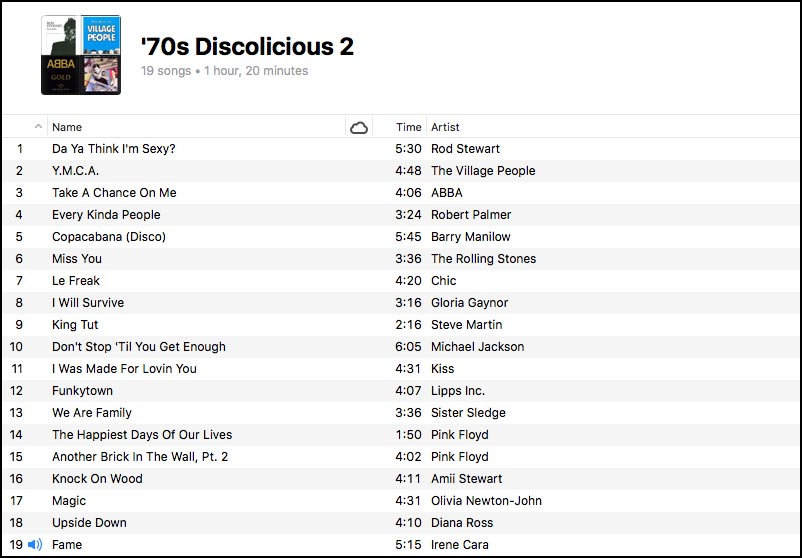
LET THERE BE ROCK
Often, the heaviest hitters of the late ’70s (Led Zeppelin) were deemed uncommercial and unsuitable for mass consumption by our corporate media overlords (no different than today). Slick, yet tuneful acts like Chicago, Eagles, and Fleetwood Mac are examples of AOR artists who had enough pop savvy to occasionally mingle on the AM dial with soft rock staples like Carly Simon & Carpenters, but it was a really rough road for most. You can only imagine how wild it must have been to see a “dangerous” act like ostentatious heavy-glam-rockers Kiss ascend to the highest level of pop culture oversaturation. They were everywhere – Network TV specials, movies, Halloween costumes, lunch boxes, comic books, pin ball machines, trading cards, toys – you name it. Musically, Kiss were fundamentally a pretty straight-forward, not particularly accomplished hard rock band, but their image… With faces caked in full black & white horror makeup and bodies draped in black & silver spandex (…or in Gene Simmons‘ case, faux blood-soaked spiked body armor with silver stilettoed demon-headed boots…), only Ziggy-era Bowie, Liberace, Parliament, and Gary Glitter could compete with the outrageousness of their stage personas and showmanship.
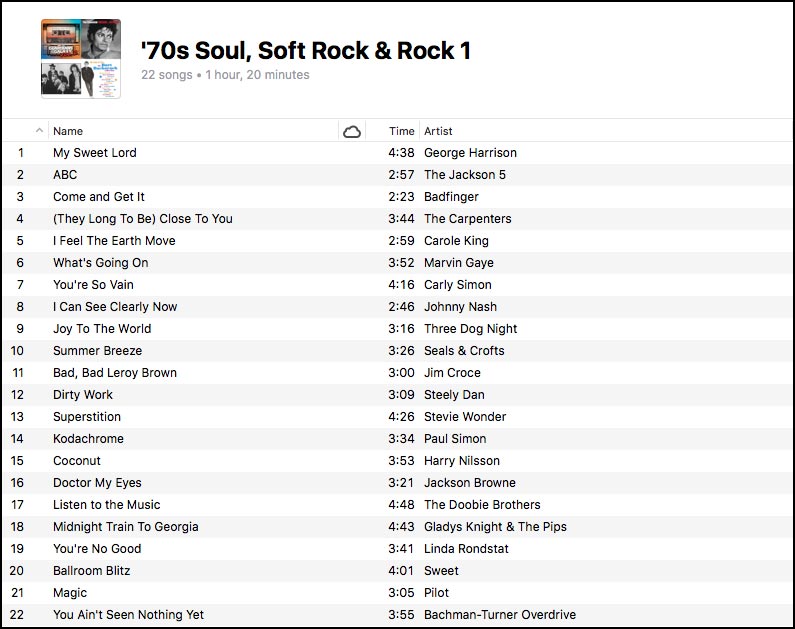
By c. ’79, my oldest sister and brother, now high schoolers, were developing tastes independently of parental influence. Her choices leaned toward mellow, “unthreatening” (parent friendly) soft-rock styles (Barry Manilow, Carpenters, Neil Diamond, Air Supply) and the uptempo bubble-gum glam of Bay City Rollers. In contrast, his tastes were becoming increasingly influenced by the way-too-loud-and-or-weird-for-the-parents hard rock/prog of Boston, The Who, Styx, Foreigner, ELP and Rush – acts featured on FM rock radio. I shared a room with my brother, so naturally his listening habits had grown to be a greater influence on me. When he brought home The Cars debut cassette, the worm turned for me as well. Played on his trusty old Panasonic box cassette player-recorder, that album (joined quickly in rotation by The Cars‘ follow-up, Candy-O) played with near dogmatic reliability virtually every single night at bedtime for what feels must have been a solid year. I was getting balled-out by table-mates in 2nd grade for incessant finger tapping because the song “Just What I Needed” continued to play on it’s own in my head long after the tape ended (hiss-delay… “click”). Aligned by the music press with other New Wave bands (XTC, Elvis Costello, Talking Heads, B-52’s, Devo, Split Enz), they are actually a difficult group to pigeonhole. While Rik Ocasek’s strangely disaffected vocals & Greg Hawk’s synthesizers definitely bubbled and quirked like New Wave, the band’s heavy riffs, rhythms, deep melodic hooks, and clear affinity for old time rock & roll (Elliot Easton’s tuneful solos) were strongly in-line with the power pop of Cheap Trick. We really didn’t think about it that deeply back then. We knew it sounded a little different, but (sorry for clumsily paraphrasing Mick Jagger) it was still “only rock and roll and we like(d) it!”

To be continued in…
THE FORMATIVE YEARS, PT III:
GOING WHERE NO (BOY) HAD GONE BEFORE A LONG TIME AGO IN A GALAXY FAR, FAR AWAY…
Whoa. This post was one epic sprawling array of references stuffed into a nifty time capsule. It’s almost as if you want to document your childhood before you start forgetting it?!? Since I lived through the same period, it is still enjoyable to re-live those days. Thanks again for the trip and it looks like the next post is going to cover Star Wars? Can’t wait.
My husband David grew up in 70s and he believes strongly that the music was better than the 80s…
Thanks for commenting Amy! It’s possible that because of his age, David has a lack of objectivity in the matter, but at this point I’m inclined agree – but I’d go a step further and argue that the music of the ’60s perhaps outshines all other eras. I find that over the course of my life, the greatest percentage of the music I have been drawn to is influenced in no small part by the British Invasion acts (Beatles, The Kinks, The Who, Rolling Stones, Pink Floyd) and their North American counterparts (Bob Dylan, Beach Boys, The Byrds, The Band, Hendrix).